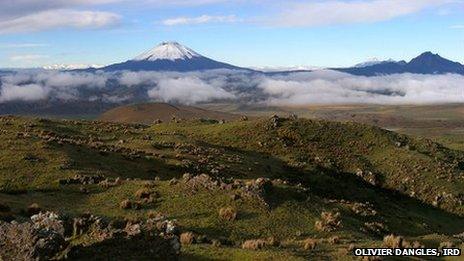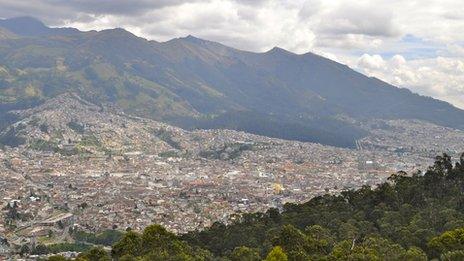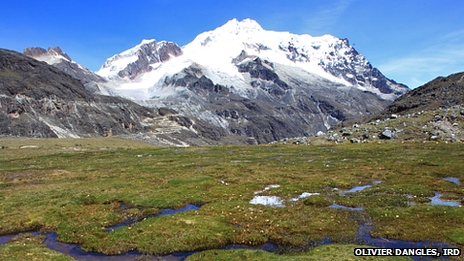Andean water 'sponges' being squeezed by changing climate
- Published

Paramos, such as this one in Ecuador, are key to local water supplies
Scientists researching future water supplies in the Andes are increasingly worried that high-altitude cities like Quito and Bogota could be adversely affected by warmer temperatures drying out grassland areas known as "paramos", as James Painter reports.
The paramos are cold and moist grasslands and shrublands that cover the mountainsides of the northern Andes from Venezuela to Peru, at elevations of between 3,000m and 5,000m (10,000-16,400ft).
Scientists say the way the paramos react to climate change could have a much bigger impact on water supplies for some cities than melting glaciers.
"Like glaciers, paramos act like vast sponges, storing and releasing water," says Quito-based Bert De Bievre, the co-ordinator of the region-wide Consortium for Sustainable Development of the Andean Ecoregion (CONDESAN).
"But overall, the paramos store a lot more water in their soil than glaciers."
Growing threat
A major problem facing the paramos is that higher global temperatures could dry out the soil and vegetation, thus reducing their capacity to trap surplus water in the rainy season and releasing it in the dry season.
Mr De Bievre was one of the authors of a recent study that used computer modelling to suggest significant losses to paramo areas this century when temperatures increase.
The reduction in the size of the paramos would add another layer of stress to water supplies already under threat from population growth, melting glaciers and changes to agriculture.
"Cities throughout the Andes are facing huge water pressures in the future," says Wouter Buytaert, an Andean water specialist at Imperial College London.
"Population growth will probably be the biggest driver of declines in per capita water availability. But some cities are also particularly vulnerable to changes to the paramos."
Mr Buytaert points out that the cities of Quito and Cuenca in Ecuador, and the Colombian capital, Bogota, get most of their water from the paramos.
Patricio Falconi Moncayo, a senior engineer at Quito's water company EPMAPS, is very aware of the crucial role the paramos play in regulating the water supply to the Ecuadorean capital.
"We recently bought a large hacienda under the Antizana volcano to help us protect the paramo," he explains.
"Along with other measures, this will help the supply of water to the Mica reservoir, which feeds 600,000 inhabitants in the southern part of Quito."
Quito residents also pay a small percentage of their water bill into a fund to help conserve the paramo.
It is thought to be the only such initiative in Latin America.
Thirsty population
Another problem Mr Falconi identifies is the high personal consumption of water by Quito's population. It is estimated to be 250 litres (55 gallons) per person per day, compared to 100 litres in the United Kingdom.

Quito residents contribute to a paramo conservation fund through their water bills
But Mr Falconi says they have achieved a significant reduction due to educational campaigns.
Scientists are at pains to point out that there are a lot of uncertainties affecting Andean water supplies in the future.
In particular, it is not known with much accuracy what will happen to regional rainfall patterns as temperatures rise.
For example, Mr Buytaert has carried out studies showing that water depletion as a result of climate change can rise by as much as 10% or fall by up to 10%, depending on rainfall patterns and other factors like evaporation.
Quito is not the only Andean city to be at risk. La Paz in Bolivia is estimated to rely on surrounding glaciers for between 15% and 27% of its water depending on the season.
Managing expectations
Along with rain and snowfall, glacial water feeds into high altitude wetlands known as bofedales, which also play a significant role in water regulation.

High altitude wetlands could also be affected by warming temperatures
But not much is known about how bofedales will be affected by climate change.
Scientists say there is an urgent need for more research on both wetland and dryland areas in the Andes to get a better sense of what will affect water supplies in a warming world.
"We need to know much more about water storage and regulation mechanisms in high altitude organic soils, and how those would change under warmer conditions," warns Mr De Bievre.
"This would allow water officials in Andean cities to know better what to expect."